How to create "Topol"
The study of the future of the missile complex with an intercontinental ballistic missile, later called the Topol, began in the mid-seventies. The work was carried out at the Moscow Institute of Thermal Engineering (MIT) under the guidance of A.D. Nadiradze The designers studied the possibility of creating a new complex based on a three-stage solid-fuel MBR. It was planned to be used with mobile launchers based on one of the promising chassis. In the new project it was planned to use certain developments in the existing complexes of similar appearance.
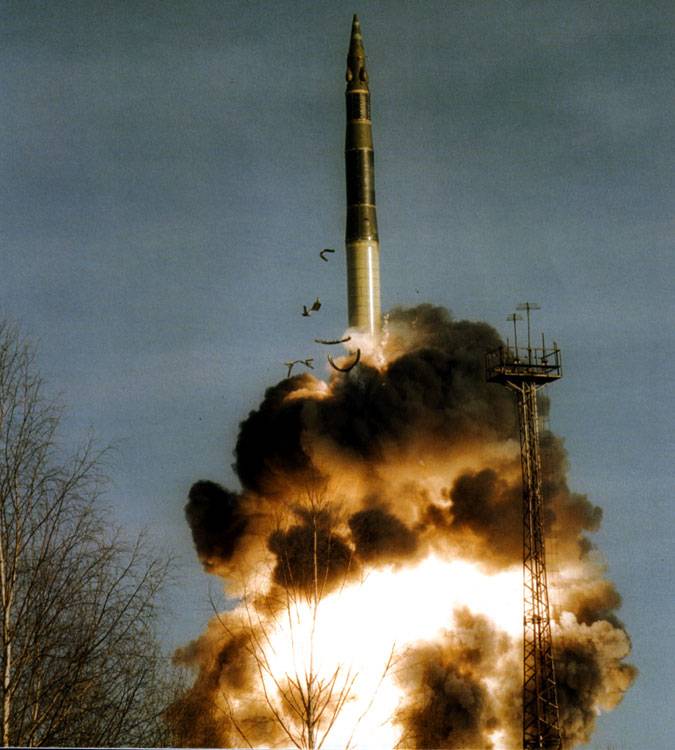
Start rocket RT-2PM. Photo Rbase.new-facrtoria.ru
After some preliminary work, 19 July 1977, a decree of the USSR Council of Ministers was issued, according to which MIT was to develop a full-fledged rocket design and launchers for it. Taking into account the results of the preliminary study, it was necessary to ensure that the rocket could only be launched from a wheeled self-propelled machine. Mine basing was not planned. The rocket itself was supposed to carry a monoblock warhead with a special charge and deliver it to a range of more than 10 thousand km.
Special attention was paid to the creation of a mobile launcher. It is this component of the complex that distinguishes it from other systems in use that should ensure sufficient combat survivability in the event of the start of a full-scale conflict. It should be noted that such requirements were directly related to foreign achievements in the field of rocket weapons.
In the mid-seventies, the likely enemy put on duty new intercontinental missiles, which were distinguished by increased accuracy. Such a weapon could have shown outstanding results in the first disarming strike. It was able to disable a significant part of the existing stationary launchers of the Soviet Strategic Rocket Forces. The transfer of missiles to mobile launchers, in turn, made it extremely difficult to strike at them, and therefore made it possible to maintain a sufficient grouping of missiles for an attack response.
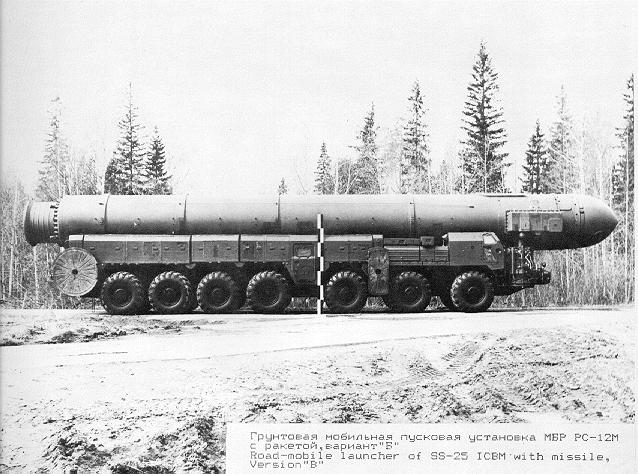
Launcher complex "Topol". Photo from the treaty START-I / State.gov
In accordance with the decision of the Council of Ministers, the new project received the code "Topol". Also, the project, the complex and the rocket received a number of other designations and names. So, the rocket was designated as RT-2PM. Despite the similarity of the designations with the existing RT-2P, the new product did not have a direct relationship to the serial rocket. The complex as a whole was assigned the index GRAU 15P158, to the rocket - 15Ж58. Later, in the framework of the START I Treaty, the designation PC-12М was introduced. NATO countries call the Russian "Topol" SS-25 Sickle.
In addition to the Moscow Institute of Thermal Engineering, a number of other organizations were involved in the development of a promising mobile soil rocket complex (PGRK). Production of pilot and serial ICBMs was planned to be launched at the Votkinsk plant. The development of control and aiming systems was entrusted to the Leningrad Optical-Mechanical Association and the Kiev plant Arsenal. Self-propelled vehicles, including the launcher, were developed jointly by the Minsk Wheel Tractor Plant and the Barrikady Production Association (Volgograd).
For several years, a group of Soviet enterprises conducted the necessary research, and also developed the required technical documentation. All the main provisions of the project "Topol" were formed and developed by the early eighties. After that, the production of the experimental RT-2PM missiles necessary for testing was launched. It was planned to conduct checks on several existing missile test sites.
In the autumn of 1982, specialists from MIT and other organizations arrived at the Kapustin Yar test site to organize the first test launch of a promising missile. According to some reports, in these tests it was planned to use a converted mine installation for the RT-2P rocket. October 27 first experimental product received a command to start, but the start ended with an accident. Work on the refinement of the project and test preparation continued.
The checks continued in the winter of the next 1983 year at the Plesetsk test site. On February 8, the crew of the 6 Scientific Test Board carried out the launch of a Topol rocket. This start was held in accordance with the established program and was recognized as successful. Soon, joint flight tests were continued. Until the end of the summer carried out three more launches of an experienced ICBM. Two of them were executed using the already used launcher, and in the third they used an experienced mobile launcher for the first time.
10 August 1983, the fourth test launch of the RT-2PM rocket took place, during which the self-propelled machine 15Х168 was used for the first time. According to some reports, during this test, the launcher completed its tasks, but the failure of one of the rocket systems did not allow the launch to be recognized as successful. Taking into account the available data, the authors of the project made the necessary changes and continued testing.
The flight tests of the Topol and the PGRK rocket continued to the end of 1984. During this time, 12 launches were completed, and no more than four of them were successful. In other cases, ground and airborne equipment worked correctly, ensuring the implementation of the set task. The test start took place on November 24 and completed the checks. All test launches were carried out only at the Plesetsk test site. When flying at a range close to the maximum, the training unit was delivered to the Kamchatka test site Kura.
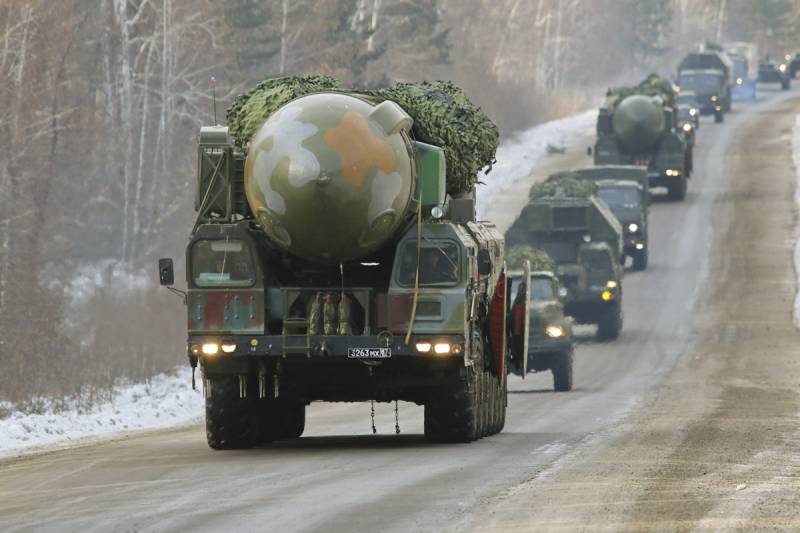
Machines complex "Topol" on the march. Photo of the Ministry of Defense of the Russian Federation / mil.ru
In the 1984 year, a few months before the completion of the flight tests of a promising complex, the construction of facilities for the deployment of new technology started. In future permanent locations and on proposed patrol routes, stationary-based structures and temporary shelters began to be built. Objects of this kind were built on the territory of existing parts that were planned to be re-equipped. In the mid-eighties, the regular program of replacing obsolete missile systems with modern ones was implemented, and the Topol system was to become its key component.
At the end of December 1984 of the year, shortly after the completion of the tests, the Council of Ministers issued a decree on the launch of mass production of a new missile system in a mobile version. Soon after, the Votkinsk plant and other enterprises engaged in the project began mass production of the required products. In Votkinsk, new missiles were being assembled, and the Volgograd enterprise built self-propelled launchers.
In the middle of July, the 1985 of the rocket regiment of the Strategic Missile Forces, stationed in the city of Yoshkar-Ola, put the first division of mobile soil complexes of a new type on experimental combat duty. A few months later, the same "novelties" received another regiment of rocket troops. It was assumed that the operation of the new technology will allow in the shortest possible time to obtain the necessary experience. From the moment of the official adoption of Topol, it was possible to begin full-fledged combat duty.
At the end of April, the first rocket regiment, fully equipped with 1987P15 complexes, took up duty on duty in the Sverdlovsk region in April. This technique was controlled by a mobile command center of the “Barrier” type. About a year later, together with the new “Topol”, troops began to supply Granit command posts, which had different characteristics and capabilities. The first such car was transferred to the Irkutsk compound of the Strategic Missile Forces in May 158.
In parallel with the supply of new serial equipment, not yet adopted for service, the personnel of the Strategic Missile Forces carried out the first training and combat launches. The first launch of the Topol rocket of this kind took place on February 21 of the year 1985. By the end of 1988, the troops had completed at least another 23 launch. All of them were held at the Plesetsk training ground and ended in a successful defeat of the training goals.
Part of the new launches was carried out in the framework of joint tests. The last test launch took place on December 23 1987. For all the time, 16 test launches were carried out, and the proportion of such launches declined over time, yielding primacy to the combat training use of missiles. From the beginning of 1988 of the year, for obvious reasons, all launches were carried out only for the purpose of training the personnel of the Strategic Missile Forces and checking available material parts.
After the completion of all the tests, as well as the delivery of a significant number of serial combat vehicles and other equipment, an order appeared to officially adopt the new system. PGRK Topol with the 15Ж58 / РТ-2ПМ missile adopted the 1 of December 1988 of the year. By this time, the rocket forces had time to get new weapons, as well as master it and perform a significant number of training launches. However, a significant number of combat units still did not pass the required re-equipment, and the supply of serial equipment continued.
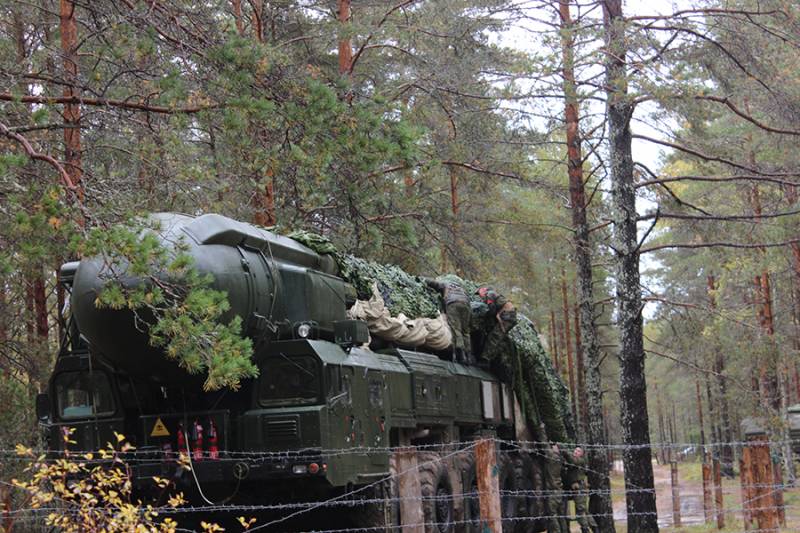
The complex is in position in a wooded area. Photo of the Ministry of Defense of the Russian Federation / mil.ru
Soon after the adoption of Topol, the Moscow Institute of Heating Engineering continued to develop the existing project, including with the aim of obtaining uncharacteristic results. So, in 1989, the project "Start" was proposed. It provided for the re-equipment of an intercontinental ballistic missile with its transformation into a carrier rocket. Starting from a standard launcher, such a carrier is capable of lifting a kg of payload to a low near-earth orbit.
At the end of 1990, rocket complexes with the Siren product from the Perimeter RC complex were put on duty. On board such a rocket, built on the basis of the RT-2PM, there is a set of special communication equipment. In case of failure of the standard means of communication of the missile troops, such missiles must ensure the transmission of control signals to combat systems of all available types.
According to known data, mass production of Topol missile systems continued until the 1993 year. Almost every year, the Strategic Missile Forces received several dozen new self-propelled launchers and missiles. The peak production of machines 15У168 fell on 1989-90 years, when the troops received almost a hundred and fifty units of equipment. In other years, the number of serial samples placed on duty did not exceed 20-30 units. A total of 1984-1993 mobile soil complexes were built from 350 to 360 years. The number of built rockets is unknown, but probably exceeds several hundred.
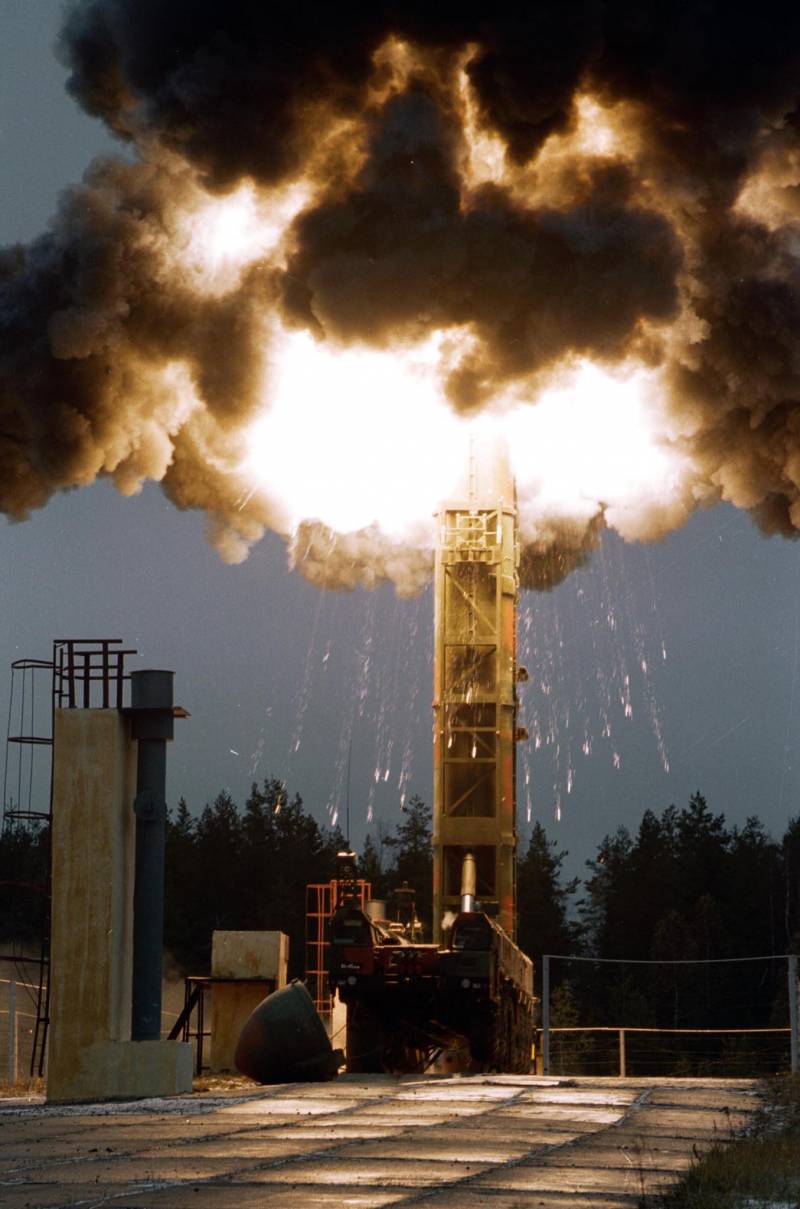
Start rocket RT-2PM, view of the launcher. Photo of the Strategic Missile Forces / pressa-rvsn.livejournal.com
The emergence of treaties on the reduction of offensive weapons led to the emergence of plans to partially abandon the existing 15P168 / PC-12M complexes. Nevertheless, the reduction of armaments was carried out mainly at the expense of obsolete models. The command tried to keep the maximum number of new Topol PGRK on duty.
In the late nineties, mass production of the upgraded Topol-M missile systems began, but this did not lead to the rapid abandonment of the existing Topol. The gradual write-off of these systems started only in a few years. So, at the end of the last decade, several dozen launchers with consumed resources had to be disposed of. In connection with the regular conduct of combat training launches and the gradual utilization of the number of deployed missiles by the time reduced and slightly exceeded 200-210 units.
According to the latest data, only 70 Topol complexes with RT-2PM missiles are currently on duty as part of the Strategic Missile Forces. In time, the new Topol-M systems of mine and mobile bases surpassed the predecessor in their numbers. The most modern PC-24 complexes "Yars", as far as we know, have so far managed to circumvent the number of Topoli and Topoli-M in terms of quantity. It should be noted that both Topol-M and Yars to some extent represent options for the further development of the Topol complex. The Moscow Institute of Heat Engineering, developing these systems, implemented a number of new ideas, and with their help provided an improvement in the technical characteristics and combat qualities of rockets.
The existing mobile ground 15P168 “Topol” missile systems have already managed to develop a significant part of the resource, and the missiles have expired storage periods. In addition, they no longer fully meet the requirements of the foreseeable future. To date, the command of the missile troops has determined the fate of the existing systems. Back in 2013, a missile disposal line was launched, and over the past years, several dozen missiles were sent to this facility.
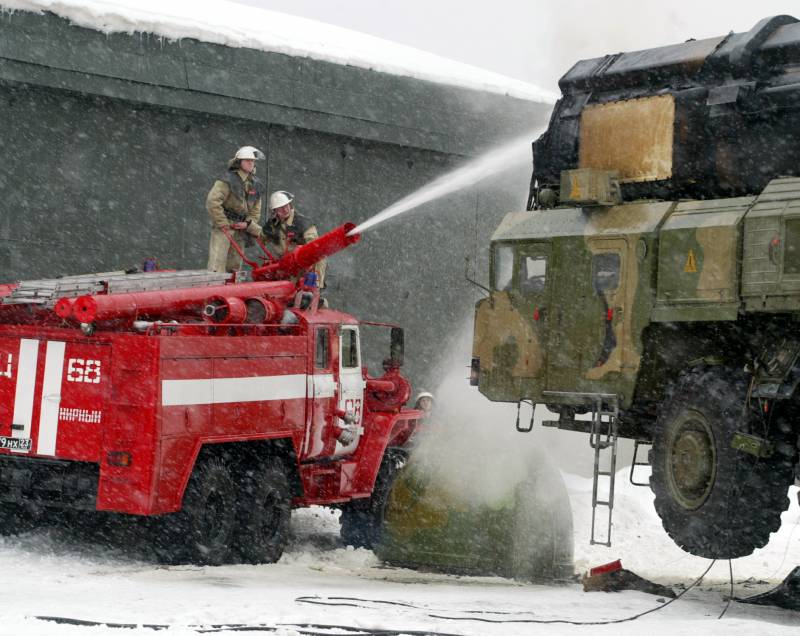
Cooling of the transport starting container after launch. Photo of the Strategic Missile Forces / pressa-rvsn.livejournal.com
At the beginning of the next decade, the aging Topoli will be decommissioned. After that, all or almost all of the available missiles and launchers will be taken for disassembly and disposal. Perhaps some products will be preserved and, after known improvements, will be included in the exposition of various museums.
After the final write-off of all Topol PGRK, the grouping of mobile missile systems will consist of several dozen Topol-M and Yars combat vehicles. In the future, it is possible to create new systems of this kind, in which one or another successful ideas proposed and implemented in the early eighties will continue to be used.
A few days ago was the 35-th anniversary of the first successful launch of the RT-2PM rocket. In the summer 35 will be celebrated since the day of the first launch of such a rocket from a mobile launcher. On the first day of winter, the Strategic Missile Forces will celebrate the thirty-year anniversary of the adoption of the Topol complex. In the future, these complexes, distinguished by a solid age and approaching the end of the service, will finally give way to newer systems and will be removed from service. However, over the next few years, they will remain in the ranks and help form a full-fledged nuclear-missile shield.
On the materials of the sites:
http://ria.ru/
http://tass.ru/
http://nvo.ng.ru/
http://rbase.new-factoria.ru/
http://kapyar.ru/
http://militaryrussia.ru/blog/topic-600.html
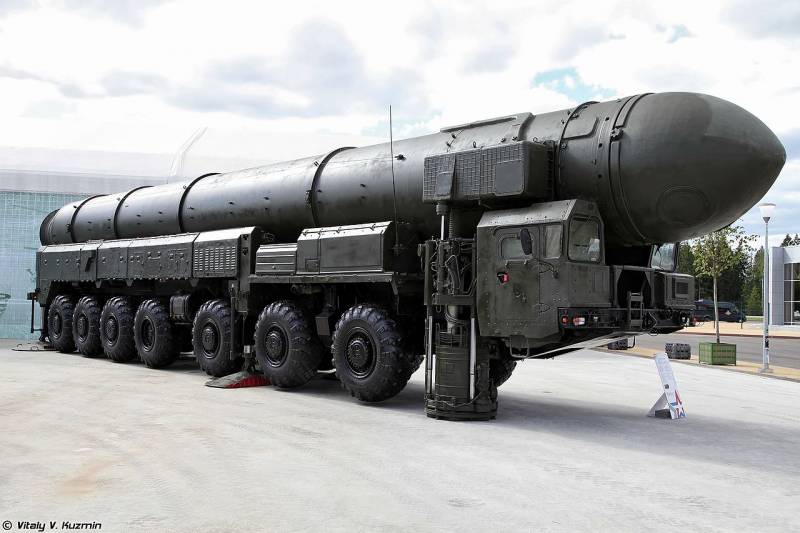
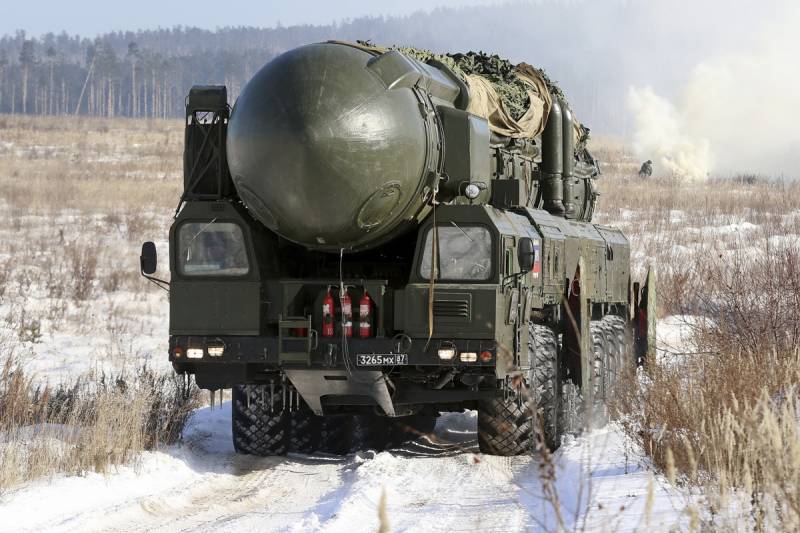
Information